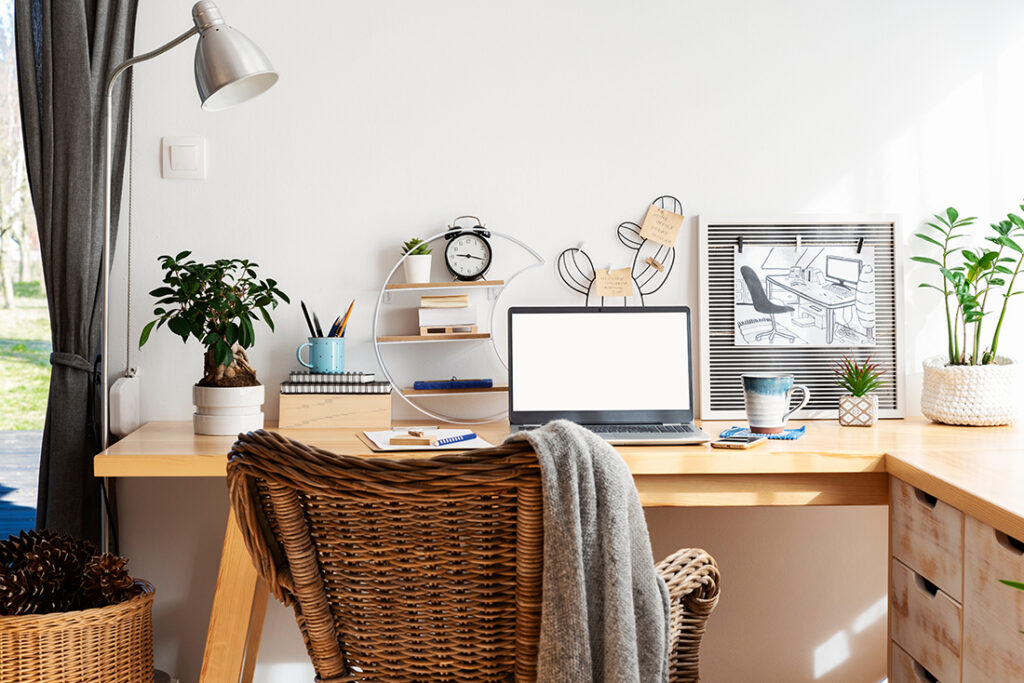Ever wonder if your workspace is helping you be as calm and efficient as possible? Many of us are so busy trying to get all our work done that we don’t stop to take in and appreciate the environment where we spend so much of our time. With more people trying to manage stress and anxiety while staying as productive as possible, it is imperative to practice mindfulness at work and set up your workspace to boost overall health, well-being and success, whether working from home or in an office.
To determine if your workspace is serving you with these goals in mind, you can conduct a mindfulness audit. Similar to an energy audit, a mindfulness audit assesses the space so you can make personal changes for maximum peace and productivity.
In The New Mindful Home (And How to Make it Yours), interior stylist and author Joanna Thornhill explains that creating a mindful room “is about far more than simply picking out a wallpaper pattern that cheers us up or doing a bit of decluttering. It’s about paying attention throughout the day to what we surround ourselves with, and questioning what is (or isn’t) supporting us.”
By taking the time to mindfully review your workspace, you can better understand your needs and create a work environment that nourishes and inspires you rather than overwhelms and hinders you.
How mindfulness at work creates a better work environment
Mindfulness involves being fully present in the moment in a nonjudgmental way, according to Jon Kabat-Zinn, a leading expert on mindfulness. “By integrating mindfulness principles into the audit process itself, we can approach the evaluation with clarity and insight,” explains Beverly Walpole, Ph.D., a registered psychologist who focuses on holistic wellness and designing healthy and mindful spaces. “This allows us to notice our surroundings without getting caught up in critical or negative thoughts, ultimately helping us create a work environment that supports our well-being and productivity while fostering a sense of presence and contentment.”
Incorporating positive mindfulness triggers into a workspace also provides numerous benefits. “Mindful elements, such as nature-inspired décor… personal reminders of mindfulness practices and designated spaces for meditation or reflection, promote a sense of calmness, focus and connection to the present moment… and can cultivate a positive and supportive work environment,” notes Walpole.
How to get started on your mindfulness audit
Anyone can conduct a mindfulness audit, but if you feel overwhelmed and need guidance, bring in a professional, such as an interior designer, professional organizer or certified wellness coach.
Focus on the present moment
The first step, according to Walpole, is to focus your attention on the present moment when you enter your office to capture details that you otherwise might not notice. “Close your eyes, take a few deep breaths and then open [your eyes] to observe your surroundings mindfully.”
Next, “reflect on how the workspace makes you feel emotionally,” Walpole continues. “Notice if certain elements evoke stress, anxiety or distraction and identify opportunities to cultivate a more positive and uplifting atmosphere. Personal touches such as artwork, photos, or inspirational quotes can contribute to a sense of connection and well-being.”
Thornhill suggests that people closely tune in to how they want the space to make them feel. “It’s important to get clear on your emotional needs,” she advises. “Work can doubtless be stressful at times, so a space that feels calm and soothing is key, yet it doesn’t want to be so soothing that you feel sleepy and switched-off [during those times] when you need to feel energi[z]ed and uplifted.”
Once you understand your needs, “you can then layer in design elements and objects [that] will support this” and set up the room accordingly. “You might want the view directly from your desk to feel calm and tranquil… [or you might want to] add in an armchair to provide you with a more energi[z]ing corner to sit and brainstorm ideas,” Thornhill adds.
Throughout the audit, Walpole and Swerdlow suggest reflecting on the following questions:
- How do I feel in my workspace?
- What is my favorite part of the room?
- What aspects of my workspace help me feel calm and focused?
- Are there any elements of my workspace that trigger negative emotions?
- Is anything causing a distraction?
- How can I modify my workspace to better support mindfulness and well-being at work?
- What elements or objects could I bring in to create a more serene and productive environment?
Evaluate key décor attributes
By systematically assessing the following elements, you can identify areas for improvement and make targeted changes to enhance mindfulness and well-being in your workspace. Spend time in your office observing which of these pieces you already have and what more can be added.
Evaluate the physical layout
Evaluate the placement of furniture and other items in the room. Pippa Jameson, interior stylist and author of The Sensory Home: An Inspiring Guide to Mindful Decorating, suggests “divid[ing] your workspace into zones for different tasks, such as a designated area for computer work, a comfortable corner for reading or brainstorming and a space for stretching or meditation breaks. This allows you to switch between activities and maintain focus throughout the day.”
Trina Swerdlow, mindfulness trainer, artist and author of Stress Reduction Journal: Meditate and Journal Your Way to Better Health, loves having a zafu (meditation cushion) in her home office to sit on. “This enables me to take a midday meditation break that includes burning a sage smudge stick for a few minutes… [and sinking deep] into my zafu with [my] eyes closed…. [This] helps me… get grounded. Then, I [can] re-enter my workday with increased clarity, creativity and calm.”
Use good lighting
Lighting can impact your work quality and how you feel. Walpole claims that “harsh fluorescent lighting can contribute to eye strain and fatigue, whereas natural light or softer, warmer lighting can promote a more relaxed atmosphere.” She suggests “maximizing exposure to natural light or using full-spectrum lighting” to improve mood and productivity.
Jameson adds that it’s also helpful to “position your workstation near a window to maximize natural light exposure [and] use adjustable curtains or blinds to control glare and brightness levels.”
Pick a color that feels calming
Color can easily shift your mood and impact your work and overall well-being. Thornhill recommends taking a moment to check in and see how certain colors elicit different emotions. Color psychology offers some general rules of thumb: blue and green can be calming, yellow can boost happiness, red can trigger excitability and creativity and orange can increase alertness.
Jamie Gold, wellness design consultant and author of Wellness by Design: A Room-by-Room Guide to Optimizing Your Home for Health, Fitness, and Happiness, says that while color preferences vary by person, she still has some recommendations. “For someone who has a high-stress job, soothing blue or green walls might be a better choice. For someone who works in a career that might sadden them, cheerful yellow could be a good choice,” she says.
Pay attention to sensory stimuli
Pay close attention to stimuli in your work environment, such as sounds, smells and tactile sensations. Do what you can to minimize distracting noises as well. Jameson suggests decorating with “sound-absorbing materials, such as rugs, curtains or acoustic panels, to dampen noise and create a more peaceful environment.”
Swerdlow says, “A tabletop water fountain… offer[s] a relaxing sound, as if a stream is nearby.” She also advises getting “a mindfulness bell or chime… that is set to ring at intervals throughout the day” to provide a mindfulness reminder.
Next, scents can alter a room and our mood. “Essential oils dispensed from a diffuser can help create a vibrant, aromatic workspace,” she adds.
Finally, according to Jameson, feeling certain textures on our skin can be a comforting and healthy distraction, so incorporating appealing textures in our office through fabrics, flooring and other items can help promote mindfulness.
Connect with nature
Walpole encourages clients to incorporate nature into their workspaces since research shows how such biophilic elements can reduce stress and “enhance well-being, creativity and cognitive function.” Adding nature is especially helpful to balance all the technology in the office, such as wires and screens.
“Add potted plants or fresh flowers to your desk to improve air quality and reduce stress,” Jameson adds. “Nature-inspired artwork or photographs can also evoke feelings of tranquility and connection to the outdoors.” And, of course, if it’s possible to set up your desk so you have a view outside, take advantage of that opportunity.
Incorporate mindfulness prompts
Incorporating items around your office that trigger mindfulness moments is vital. “Placing reminders of mindfulness practices… [or] physical objects such as meditation cushions or inspirational quotes can encourage moments of reflection and presence throughout the workday,” reflects Walpole. “Customizing [your] workspace with personal items, such as photographs or artwork… [also] foster[s] a positive emotional connection to the environment.”
By taking the time to mindfully assess how your workspace is impacting your mood and work, you can take the necessary steps to transform the area where you spend so much time and energy. “I believe there’s a high return on investment when we create a mindful workspace that amplifies our effectiveness—while soothing our souls,” Swerdlow concludes.
Photo by liloon/Shutterstock.com



